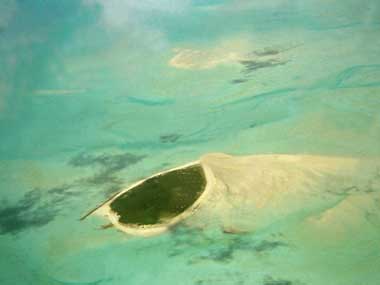Ashmore Reef Commonwealth Marine Reserve (formerly Ashmore Reef National Nature Reserve) is located in the north-eastern Indian Ocean on the edge of Australia’s North West Shelf. The Reserve is in Australia’s External Territory of Ashmore and Cartier Islands and is under the jurisdiction of the Australian Government. It is the largest of only three emergent oceanic reefs present within the north-eastern Indian Ocean, and is the only oceanic reef in the region with vegetated islands. The Reserve is comprised of numerous marine habitats and supports a regionally important and diverse range of species. The Reserve has been recognised internationally for its high diversity and density of sea snakes. The Ramsar site is also home to Dugongs, highly diverse reef building corals, and numerous endemic species of fish and other marine invertebrate fauna. The three vegetated islands and several sand cays of the Reserve include important seabird and turtle nesting sites and support large populations of migratory shorebirds and breeding seabirds. Ashmore has been regularly visited and fished by Indonesians since the early eighteenth century. Indonesian artefacts identified in the Reserve include ceramics, graves, ballast rocks and what could be a trepang (sea cucumber) cooking site.Tourism and recreation as well as access to shelter and water for traditional fishers from Indonesia in the Reserves is mainly limited to West Island Lagoon and part of West Island. Research relevant to the Reserve and nearby reefs has included surveys, monitoring and/or research on terrestrial and marine non-indigenous species, sea birds, migratory shorebirds, sea snakes, fish, corals, sea cucumbers, trochus, clams, cephalopods and other marine invertebrates.
Ashmore Reef Commonwealth Marine Reserve

Government evidence of impact of climate change:
-
Australian Government, Ashmore Reef Commonwealth Marine Reserve Ramsar Site, Ecological Character Description
Actual or likely threat Potential impact(s) to wetland Likelihood’ Timing components; processes and or service Biological resource use Changed fish community Medium Immediate to fishing and hunting composition long term marine fauna Ecological effects to reef community Oil and gas exploration Impacts to turtles; dugongs and Certain Immediate to and mining seasnakes from underwater long term noise Increased risk of boat strike Decreased diversity and abundance of fauna due to toxic effects of oil spills Invasive species (ginger Impacts to nesting success of Certain Immediate ant) seabirds and marine turtles O Medium Immediate Invasive species (weeds and pest animal species) Climate change Sea temperature; sea level; acidification Impacts to diversity and abundance of terrestrial species and habitats.
The general climatic pattern is warm to hot temperatures and low rainfall.
Driver Climate change severe weather Temperature extremes; acidification; storms; sea level rise Biolgical resource use Hunting marine fauna; fishing Invasive species Non native invasive species Pollution Garbage and solid wastes Energy production and mining Oil and gas drilling Stressor Increased temperature Decreased pH Sea level rise Direct species removal Ginger ants (Solenopsis geminata) Marine debris Toxicants (hydrocarbons) Species mortality (coral; sea snakes) Decreased populations (molluscs; fish sea cucumbers; turtles) Disruption of breeding (loss of nesting habitat turtles seabirds) Ecologcal effect Species mortality (birds; reptiles; dugong) Altered community composition Increased predation (seabird and turtle eggs) Critical component; process or service Component marine invertebrates Service near natural wetland types; biodiversity; threatened species Component Fish Service biodiversity; threatened species Component Sea snakes Service biodiversity; threatened species Component Marine turtles Service biodiversity; threatened species Component Seabirds and shorebirds Service biodiversity; priority species; threatened species Component Dugong Service biodiversity; threatened species Figure 26 Stressor model of the Ashmore Reef Ramsar site (after Gross 2003; Davis and Brock 2008). 5.1 Biological resource use Fishing and hunting of marine fauna have historically been major activities in the Ashmore Reef Ramsar site.
The Intergovernmental Panel on Climate Change (IPCC) projections are for a rise of 18 to centimetres by 2095 compared to 1990 (IPCC 2007).
Climate change Loss of vegetation and sand Certain Long term Sea temperature; sea habitat; leading to a decline in level; acidification seabird and turtle nesting sites Increase in coral bleaching and disease Impacts to fauna such as seasnakes from increased temperatures Changes to marine flora and fauna biodiversity either directly or through habitat alteration Marine debris Ingestion by feeding birds; fish; Medium Immediate reptiles and mammals.
Actual or likely threat Potential impact(s) to wetland Likelihood’ Timing components; processes and or service Biological resource use Changed fish community Medium Immediate to fishing and hunting composition long term marine fauna Ecological effects to reef community Oil and gas exploration Impacts to turtles; dugongs and Certain Immediate to and mining seasnakes from underwater long term noise Increased risk of boat strike Decreased diversity and abundance of fauna due to toxic effects of oil spills Invasive species (ginger Impacts to nesting success of Certain Immediate ant) seabirds and marine turtles O Medium Immediate Invasive species (weeds and pest animal species) Climate change Sea temperature; sea level; acidification Impacts to diversity and abundance of terrestrial species and habitats.
Driver Climate change severe weather Temperature extremes; acidification; storms; sea level rise Biolgical resource use Hunting marine fauna; fishing Invasive species Non native invasive species Pollution Garbage and solid wastes Energy production and mining Oil and gas drilling Stressor Increased temperature Decreased pH Sea level rise Direct species removal Ginger ants (Solenopsis geminata) Marine debris Toxicants (hydrocarbons) Species mortality (coral; sea snakes) Decreased populations (molluscs; fish sea cucumbers; turtles) Disruption of breeding (loss of nesting habitat turtles seabirds) Ecologcal effect Species mortality (birds; reptiles; dugong) Altered community composition Increased predation (seabird and turtle eggs) Critical component; process or service Component marine invertebrates Service near natural wetland types; biodiversity; threatened species Component Fish Service biodiversity; threatened species Component Sea snakes Service biodiversity; threatened species Component Marine turtles Service biodiversity; threatened species Component Seabirds and shorebirds Service biodiversity; priority species; threatened species Component Dugong Service biodiversity; threatened species Figure 26 Stressor model of the Ashmore Reef Ramsar site (after Gross 2003; Davis and Brock 2008). 5.1 Biological resource use Fishing and hunting of marine fauna have historically been major activities in the Ashmore Reef Ramsar site.


